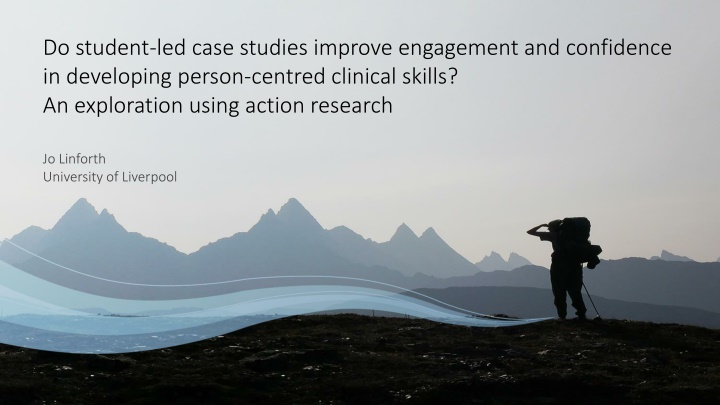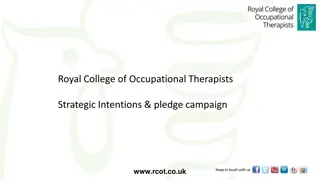
Improving Clinical Skills Through Student-Led Case Studies: An Action Research Exploration
Explore how student-led case studies enhance engagement and confidence in developing person-centered clinical skills. Action research methodology is utilized to evaluate the effectiveness of this approach, focusing on interpreting MOHOST for goal setting and intervention planning. Discover strategies for effectively integrating case study approaches in teaching to encourage reflection, application of clinical skills, and reducing fear in working with mental health clients.
Download Presentation

Please find below an Image/Link to download the presentation.
The content on the website is provided AS IS for your information and personal use only. It may not be sold, licensed, or shared on other websites without obtaining consent from the author. If you encounter any issues during the download, it is possible that the publisher has removed the file from their server.
You are allowed to download the files provided on this website for personal or commercial use, subject to the condition that they are used lawfully. All files are the property of their respective owners.
The content on the website is provided AS IS for your information and personal use only. It may not be sold, licensed, or shared on other websites without obtaining consent from the author.
E N D
Presentation Transcript
Do student-led case studies improve engagement and confidence in developing person-centred clinical skills? An exploration using action research Jo Linforth University of Liverpool
How can I better preach what I practised? And practice what I preach?
The module The module BSc Undergraduate Year 2, semester 1 module BSc Undergraduate Year 2, semester 1 module Focuses on students interpretation of MOHOST for a range of case studies, and using this analysis to develop and justify appropriate goals and intervention plans Clinical reasoning is underpinned by application of MOHO and relevant frames of reference
The process of action research Move in new directions Began by mistake Modify Observe Taken on as part of Postgraduate Certificate in Academic Practice Evaluate Reflect Exploring my practice alongside my students McNiff and Whitehead (2006) Act
Bringing my perspective of person-centred practice to my teaching Valuing and celebrating difference Focusing on the individual, their lived experience and their aspirations Developing self-confidence with self-reflection and open curiosity Busting some myths The transformative process - putting on the occupational therapy lenses forever!
How can I more effectively, use a case study approach within my teaching to facilitate students to: Consider the person first, diagnosis second Reflect on the impact of lived experience Confidently apply Confidently apply clinical skills clinical skills within the OT within the OT process, process, underpinned by underpinned by MOHO MOHO View a person s situation through an occupational therapy lens Reduce fear and confusion in relation to working with people with symptoms of mental illness
My journey My journey Modify Observe Modify Observe 2019 2019 Modify Observe Evaluate Reflect 2018 2018 Evaluate Reflect 2017 2017 Act Evaluate Reflect Act Act
Observations High pass rate for the module Feedback from clinical educators that students lacked confidence or skill in developing intervention plans and demonstrating person-centred clinical reasoning on placement Formative and summative assessments suggested difficulty in applying skills - students appeared instead to be memorising standard examples Students reported feeling overwhelmed with interpreting assessments in order to begin person-centred intervention planning Students struggled to consider the person beyond the concrete information given in the case study
Reflection Students perspective: Students perspective: o Passing the assessment is the priority Memorising standard answers , the academic/placement divide o Feeling uncomfortable making assumptions which seems contrary to person-centred values o Difficulty relating to the case study students have had minimal experience in practice settings (one 4 week placement) and in some cases limited experience of human and societal diversity. o Feel overwhelmed when attempting to develop complex skills whilst also developing understanding of unfamiliar conditions Clinical Educator perspective Clinical Educator perspective o Students need to be ready to demonstrate use of the OT process and person centred thinking on placement o Students are not being prepared adequately at university? My perspective My perspective o Challenges of using case studies during my own training o My passion and experience was setting standards too high, too soon? o Person- centred? Am I practising what I preach?
Theoretical perspective Students develop their understanding by actively exploring new concepts and ideas and interpreting these through the lens of pre-existing knowledge and viewpoints (Biggs and Tang, 2011). When case studies are linked to personal experience they have been found to improve: student performance students confidence in their own abilities and understanding Likelihood that students will apply theoretical knowledge Escartin et al (2015) found that as students develop their own case studies they demonstrate high levels of originality and emotional involvement Wlodkowski and Ginsbery (2017) found robust connections between learning, motivation and emotionality for adult learners. (Estcartin et al., 2015; Saldana et al 2015)
Evaluate gathering some data Surveys given to whole cohort, during teaching time, after completion of each case study Students were asked to consider how confident they would be in applying the following skills, both in their exams, and if they were on placement: Interpreting MOHOST Identifying goals and intervention plans Demonstrating clinical reasoning Students were also asked to identify which aspects of teaching most impacted on their confidence
Initial Findings week 6 1 Not at all confident, wouldn t know where to start 2 Not confident 3 Not very confident 4 Quite confident 5 Confident 6 Very confident, no concerns Median levels of confidence reported by students (n=26) Median levels of confidence reported by students (n=26) 6.0 5.0 4.0 3.0 2.0 1.0 MOHOST (Exam) MOHOST (Placement) Planning (Exam) Planning (Placement) Reasoning (Exam) Reasoning (Placement) Tutor-led case study Student led case study
What do you feel improved your confidence? Creating our own character was helpful to use with MOHOST as it gave us a better understanding of a person to apply MOHOST to Linking the person to the MOHOST was quite easy because you were able to see what they found difficult Deciding whether symptoms were correlation or causation of anxiety Actually using the case study itself was beneficial as it made it more realistic. Filling out our own MOHOST for the teenager
Developing a person-centred plan James is keen to get involved in new activities but is struggling to do this. James finds reading and writing difficult. This has caused him to be reliant on others in explaining activities which has impacted on his ability to try new things. He does not expect success beginning an activity as he has struggled with many things in his life and feels like this will continue to be the same. He did not succeed in school. When he attends college in the future he is likely to expect things to be the same. It is likely that he has received little praise in his life which would allow him to improve this opinion of himself and which may then motivate him to do more. His poor appraisal of ability and low expectation of success could also be because his auditory hallucinations are critical of him. James energy levels are high, which will support him when he attend college to improve his academic skills. By attending these classes James will receive feedback which will help improve his personal causation, confidence and help him to understand with his abilities more effectively. This goal can may also improve his communication skills and his relationship with his family who are wary of his condition; but by James improving his communication he may be able to express how he is feeling to them . This goal will help James work towards establishing a routine and improving in his organisation which may eventually will help him to have a greater involvement in his son s life, for example picking him up from school.
Person-centred approach am I practising what I preach? facilitating expression and encouraging connection Valuing and celebrating difference meeting people where they are and working with them to reach their goal Focusing on the individual, their lived experience and their aspirations Being ready to learn together, encouraging awareness of strengths and areas for development mine and theirs! Developing self-confidence with self- reflection and open curiosity Bridging the university-placement gap Keeping the OT lenses on - to practice and to preach! The transformative process - putting on the occupational therapy lenses
References Biggs, J. B. and Tang. C. (2011) Teaching for quality learning at university. Available at: http://ebookcentral.proquest.com/lib/liverpool/detail.action?docID=798265 (Downloaded: 8 July 2019) Doyle, T., and Zakrajsek, T. (2013) The New Science of Learning: How to Learn in Harmony with Your Brain. Sterling, VA: Stylus Escart n, J. et al. (2015) The Impact of Writing Case Studies: Benefits for Students Success and Well- being , Procedia - Social and Behavioral Sciences, 196, pp. 47 51. doi: 10.1016/j.sbspro.2015.07.009. McNiff, J. and Whitehead, J. (2006) All you need to know about Action Research. London, UK, Sage Salda a, O. et al, (2015) Development of psychosocial case studies by students to improve their ability to understand and analyze human behavior , 8th International Conference of Education, Research and Innovation Conference. Seville, Spain, 16-18 November, pp1097-1102. Available at: http://diposit.ub.edu/dspace/bitstream/2445/114808/1/656199.pdf (Accessed 10 July 2019) Wlodkowski, R. J. and Ginsberg, M. B. (2017) Enhancing adult motivation to learn: A comprehensive guide for teaching all adults. San-Fransico, CA; Jossey-Bass
Confidence in Interpreting MOHOST on placement.. in the exam 6 6 5.5 5.5 5 5 4.5 4.5 4 4 3.5 3.5 3 3 2.5 2.5 2 2 1.5 1.5 1 1 Following tutor-led case study Following student-led case study Following tutor-led case study Following student-led case study
Confidence in developing goals and intervention plans in the exam on placement 6 6 5.5 5.5 5 5 4.5 4.5 4 4 3.5 3.5 3 3 2.5 2.5 2 2 1.5 1.5 1 1 Following tutor-led case study Following student-led case study Following tutor-led case study Following student-led case study
Confidence in clinical reasoning in the exam on placement 6 5.5 5 4.5 4 3.5 3 2.5 2 1.5 1 Following tutor-led case study Following student-led case study Following tutor-led case study Following student-led case study
So what? How could I dissuade students from memorising standard goals or intervention plans and instead focus on developing person-centred sills they could then transfer to practice? How could I meet the students where they are facilitating them to develop these complex skills from a firmer foundation, or familiar ground drawing on their own experience and therefore building their confidence? How could I facilitate students to feel more emotionally involved and connected to the case studies they are working with?






















